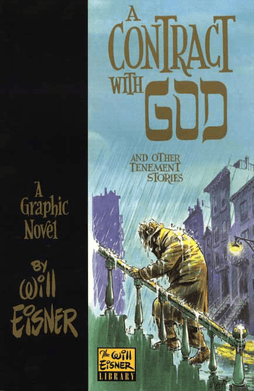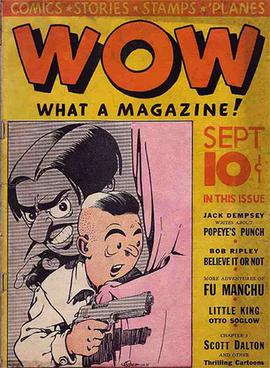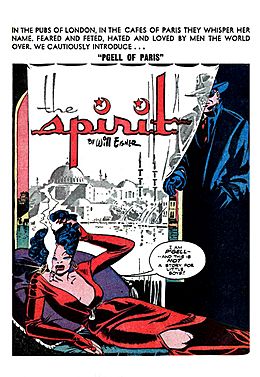Will Eisner facts for kids
Quick facts for kids Will Eisner |
|
|---|---|

Eisner in 2004
|
|
| Born | William Erwin Eisner March 6, 1917 New York City |
| Died | January 3, 2005 (aged 87) Lauderdale Lakes, Florida |
| Area(s) | Cartoonist, Publisher |
| Pseudonym(s) | William Erwin Maxwell |
|
Notable works
|
|
| www.willeisner.com | |
Will Eisner (born March 6, 1917 – died January 3, 2005) was an American cartoonist, writer, and business owner. He was one of the first cartoonists to work in the American comic book world. His famous series The Spirit (from 1940 to 1952) was known for trying new things in its stories and style.
In 1978, he helped make the term "graphic novel" popular with his book A Contract with God. He also helped start the study of comics with his book Comics and Sequential Art (1985). The Eisner Award, a major award for comics, is named after him. He was one of the first people to be added to the Will Eisner Comic Book Hall of Fame.
Contents
Will Eisner's Early Life: 1917–1936
Family and Childhood
Will Eisner's father, Shmuel "Samuel" Eisner, was born in 1886 in what is now Ukraine. He dreamed of being an artist and painted for churches and wealthy people in Vienna. To avoid joining the army, he moved to New York before World War I. It was hard for him to find work because he didn't speak much English. He painted backgrounds for shows like vaudeville and Jewish theater.
Will's mother, Fannie Ingber, was born in 1891 on a ship coming to the US. Her parents were Jewish and from Romania. She had a tough childhood, losing her mother at age ten and her father soon after. An older stepsister raised her, and she had little time for school. She later tried to hide that she couldn't read well from her children.
Shmuel and Fannie were distant relatives and met through their families. They had three children: Will Erwin (born 1917), Julian (born 1921), and Rhoda (born 1929).
Growing Up in New York
Will Eisner was born in Brooklyn, New York. His family was poor, and they moved homes often. Young Eisner sometimes had to stand up for himself when other kids were mean to him because he was Jewish. His family wasn't strictly religious, but Eisner was proud of his Jewish background.
Will was tall and strong, but he wasn't good at sports. He loved reading pulp magazines (cheap magazines with exciting stories) and watching movies. His father encouraged his interest in art by buying him art supplies.
His mother often worried about his father not earning enough money. His father tried many jobs, like selling furniture and running a coat factory, but it was hard. Things got even tougher after the Wall Street Crash of 1929, which started the Great Depression. In 1930, when Will was thirteen, his mother asked him to help earn money. He started selling newspapers on street corners, which was a very competitive job.
Eisner went to DeWitt Clinton High School. He was inspired by artists like J. C. Leyendecker. He drew for the school newspaper, the literary magazine, and the yearbook. He also designed sets for school plays, which made him think about working in theater. After high school, he studied art for a year at the Art Students League of New York. Through connections there, he got a job as an advertising writer and cartoonist for the New York American newspaper. He also drew pictures for pulp magazines, earning $10 a page.
In 1936, his high school friend Bob Kane (who later created Batman) suggested that 19-year-old Eisner try selling cartoons to a new comic book called Wow, What A Magazine!. At that time, "comic books" were mostly collections of old newspaper comic strips. But by 1935, they started to include new comic material. The editor of Wow, Jerry Iger, bought an adventure strip from Eisner called Captain Scott Dalton. Eisner also drew other strips for Wow, like "The Flame" and "Harry Karry".
Starting in Comics and The Spirit: 1936–1941
Eisner & Iger Studio
Wow magazine only published four issues. After it closed, Eisner and Iger decided to work together. They started a business to create and sell new comic book stories. They thought that soon there wouldn't be enough old comic strip reprints to fill comic books. They were one of the first "comic book packagers," meaning they created comics for publishers.
Their business was very successful right away. They soon had many artists and writers creating comics for companies like Fox Comics, Fiction House, and Quality Comics. Eisner helped create characters like Doll Man and Blackhawk for Quality Comics. They made a profit of $1.50 per page. Eisner said he became "very rich before I was 22," earning a lot of money for that time.
One of their projects was a Sunday comic strip called Hawks of the Sea. It first reprinted Eisner's old "The Flame" strip from Wow and then continued with new stories. Eisner's work even reached Europe, with him drawing a new cover for a British comic tabloid.
In 1939, Eisner was asked to create a character called Wonder Man for a new publisher, Victor Fox. Fox wanted a character similar to Superman. Using the pen name Willis, Eisner wrote and drew the first issue of Wonder Comics. Later, when the company that became DC Comics sued Fox, saying Wonder Man was too much like Superman, Eisner was called to testify.
Creating The Spirit
Will Eisner made a special deal for his new comic series, The Spirit. Even though the syndicate (the company that distributed the comics) would own the copyright at first, the contract said that if their partnership ended, the rights to The Spirit would return to Eisner. This also included other comic features that appeared with The Spirit, like "Mr. Mystic" and "Lady Luck".
Eisner sold his share of his company with Iger for $20,000. He then left to create The Spirit. He said in 1997, "They gave me an adult audience, and I wanted to write better things than superheroes. Comic books were a ghetto." He added, "They wanted a hero, a character with a costume. They asked me if he'd have a costume. And I put a mask on him and said, 'Yes, he has a costume!'"
The Spirit was a series about an urban crime fighter, usually eight or seven pages long. It appeared in a 16-page Sunday newspaper supplement, often called "The Spirit Section." This section was given out in up to 20 newspapers, reaching as many as five million readers. It started on June 2, 1940, and continued until 1952. Eisner especially liked the Spirit story "Gerhard Shnobble" because it was one of his first times putting his own feelings into the series.
Later Years: Military Work and Graphic Novels
Comics After the War
After serving in World War II, Eisner returned to his studio and created many of the Spirit stories that made him famous. In the years after the war, he also tried to start other comic series like Baseball, John Law, Kewpies, and Nubbin the Shoeshine Boy. None of these were successful, but some of their ideas were used in The Spirit.
The Spirit stopped being published in 1952. In the 1960s and 1970s, different publishers reprinted the old Spirit adventures. Eisner often drew new covers for these reprints and even created a few new stories.
American Visuals Corporation
During World War II, Eisner found a new way to use comics: for training soldiers. He created a clumsy soldier character named Joe Dope for the publication Army Motors. Joe Dope showed soldiers how to take care of military equipment. In 1948, while still working on The Spirit, Eisner noticed that television was making fewer people read newspapers. So, he started the American Visuals Corporation. This company made educational materials for the government, related groups, and businesses.
One of his longest jobs was PS, The Preventive Maintenance Monthly. This was a small magazine with comic book parts that he started for the Army in 1951. He continued to work on it until the 1970s with other artists. Eisner also made other military publications, like a graphic manual in 1969 called The M-16A1 Rifle: Operation and Preventative Maintenance. This manual was given out with cleaning kits to help with problems with the M16 Rifle during the Vietnam War.
His company also worked for other clients, including RCA Records, the Baltimore Colts football team, and New York Telephone.
The "Godfather" of Graphic Novels
Eisner said that a comics convention in 1971 made him want to return to comics. He told an interviewer in 1983, "I came back into the field because of you. I remember you calling me... I came down and was stunned at the existence of the whole world. ... That was a world that I had left, and I found it very exciting, very stimulating."

In the late 1970s, Eisner started focusing on longer stories. A Contract with God: and Other Tenement Stories (1978) is an early example of an American graphic novel. It combined short stories with a similar theme into one book. Eisner then created many more graphic novels that told stories about immigrant communities in New York, especially Jewish people. These books included The Building, A Life Force, Dropsie Avenue, and To the Heart of the Storm. He kept making new books into his seventies and eighties, almost one every year.
Some of his last works were comic book versions of famous novels and myths, like Moby-Dick. In 2002, at 85, he published Sundiata, based on the stories of a West African king. Fagin the Jew tells the story of the character Fagin from Charles Dickens' Oliver Twist, where Eisner tried to show a different side of him.
His last graphic novel, The Plot: The Secret Story of The Protocols of the Elders of Zion, was finished just before he died and published in 2005. It tells the story of how the anti-semitic hoax The Protocols of the Learned Elders of Zion was created and proven false.
In 2008, Will Eisner's The Spirit: A Pop-Up Graphic Novel was published, with Bruce Foster as the paper engineer.
Teaching and Legacy
In his later years, Eisner often gave talks about how to create and use sequential art (the art of telling stories with pictures in a sequence, like comics). He taught at the School of Visual Arts in New York City. There, he published Will Eisner's Gallery, which showed work by his students. He also wrote two important books based on his lectures: Comics and Sequential Art and Graphic Storytelling and Visual Narrative. These books are widely used by students who want to learn how to make comics.
Will Eisner's Death
Will Eisner passed away on January 3, 2005, in Lauderdale Lakes, Florida. He had complications from heart surgery he had in December 2004. DC Comics held a memorial service for him in Manhattan's Lower East Side, a neighborhood Eisner often featured in his stories.
Eisner was survived by his wife, Ann Weingarten Eisner, and their son, John. In a later edition of A Contract with God, Eisner shared that the main story was inspired by the death of his teenage daughter, Alice, in 1970. She had leukemia. He is buried next to her. Before this, only his closest friends knew about his daughter's life and death.
Awards and Honors for Will Eisner
Will Eisner received many awards for his work. He won the National Cartoonists Society Comic Book Award several times (in 1967, 1968, 1969, 1987, and 1988). He also won their Story Comic Book Award in 1979 and the Reuben Award in 1998. In 1975, he received the Inkpot Award and the second Grand Prix de la ville d'Angoulême (a major French comics award).
He was added to the Academy of Comic Book Arts Hall of Fame in 1971 and the Jack Kirby Hall of Fame in 1987. The next year, the Will Eisner Comic Industry Awards were created in his honor. In 2015, Eisner was chosen for the Society of Illustrators Hall of Fame after his death.
Will Eisner's comics are kept in the James Branch Cabell Library at Virginia Commonwealth University (VCU). This library has also been the home for the Will Eisner Comic Industry Awards since 2005. Each year after Comic-Con, the nominated and winning comics are given to the library's Special Collections and Archives. This allows researchers and visitors to study them. The VCU library has about 1,000 comic books, graphic novels, and other related items in its Comic Arts Collection.
On the 94th anniversary of Eisner's birth in 2011, Google used an image of his character, the Spirit, as its logo.
Eisner was one of the artists honored in the "Masters of American Comics" exhibition at the Jewish Museum in New York City from 2006 to 2007. To celebrate Eisner's 100th birthday in 2017, Denis Kitchen and John Lind organized the largest shows of Will Eisner's original artwork. These shows were held at The Society of Illustrators in New York City and Le Musée de la Bande Dessinée in Angoulême, France. Both shows were called Will Eisner Centennial Celebration and included over 400 original pieces. A book with the same name was released and was nominated for several Eisner Awards in 2018.
Will Eisner's Original Books
- Odd Facts (1975)
- A Contract with God (1978)
- Life on Another Planet (1983)
- Comics and Sequential Art (1985)
- New York: The Big City (1986)
- The Dreamer (1986)
- The Building (1987)
- A Life Force (1988)
- Art of Will Eisner (1989)
- To the Heart of the Storm (1991)
- The Will Eisner Reader (1991)
- Invisible People (1993)
- Dropsie Avenue (1995)
- Will Eisner Sketchbook (1995)
- The Princess and the Frog (1996) (with Jacob and Wilhelm Grimm)
- Graphic Storytelling and Visual Narrative (1996)
- A Family Matter (1998)
- Last Day in Vietnam (2000)
- The Last Knight (2000) (with Miguel de Cervantes Saavedra)
- Minor Miracles (2000)
- Will Eisner's Shop Talk (2001)
- The Name of the Game (2002)
- Fagin the Jew (2003)
- Will Eisner's John Law: Dead Man Walking (2004)
- The Plot: The Secret Story of The Protocols of the Elders of Zion (2005)
See also
 In Spanish: Will Eisner para niños
In Spanish: Will Eisner para niños



